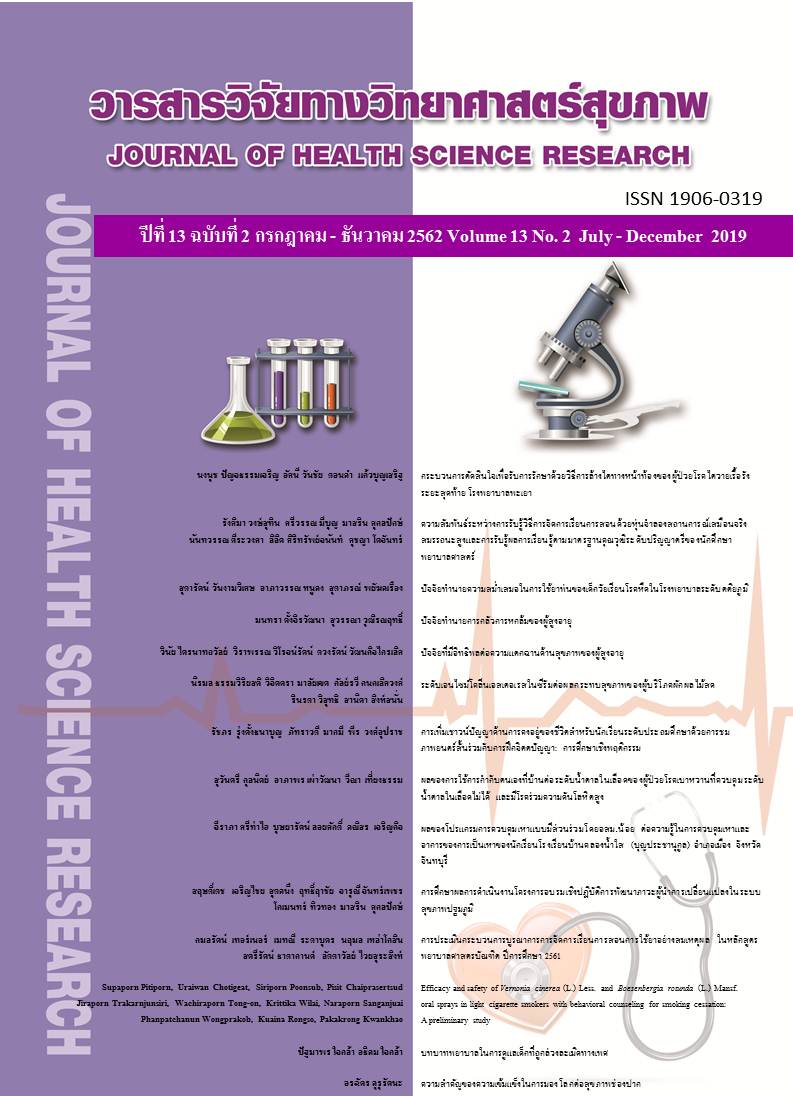ปัจจัยทำนายการกลัวการหกล้มของผู้สูงอายุ
Main Article Content
บทคัดย่อ
การวิจัยเชิงพรรณนานี้มีวัตถุประสงค์เพื่อศึกษาความกลัวการหกล้มและปัจจัยทำนายความกลัวการหกล้มของผู้สูงอายุ กลุ่มตัวอย่างจำนวน 400 คน ประกอบด้วย ผู้ที่มีอายุ 60 ปีขึ้นไปได้มาจากการสุ่มตัวอย่างแบบแบ่งชั้นจากเขตที่พักอาศัยในจังหวัดชลบุรี เก็บรวบรวมข้อมูล โดยใช้แบบสอบถามข้อมูลส่วนบุคคล ประสบการณ์หกล้มในระยะ 1 ปี ความกลัวการหกล้ม ความมั่นใจในการทรงตัว และความสามารถในการปฏิบัติกิจวัตรประจำวัน วิเคราะห์ข้อมูลโดยสถิติเชิงพรรณนา สัมประสิทธิ์สหสัมพันธ์ของเพียร์สัน และการวิเคราะห์ถดถอยพหุคูณแบบขั้นตอน
ผลการวิจัย พบว่า มีผู้สูงอายุหกล้มนาน ๆ ครั้ง ร้อยละ 34.30 และหกล้มบ่อย ร้อยละ 10.60 มีความกลัวการหกล้มในระดับมาก มีความมั่นใจในการทรงตัวระดับปานกลาง และมีความสามารถในการปฏิบัติกิจวัตรประจำวันระดับมาก ผลการวิเคราะห์ถดถอยพหุคูณพบว่าปัจจัยทำนายความกลัวการหกล้มของผู้สูงอายุที่มีนัยสำคัญทางสถิติประกอบด้วย ความมั่นใจในการทรงตัว (β = -.361, p <.001) ประสบการณ์การหกล้ม (β =.258, p <.001) และความสามารถในการปฏิบัติกิจวัตรประจำวัน (β = -.157, p<.001) ปัจจัยทั้งสามร่วมกันทำนายความกลัวหกล้มในผู้สูงอายุได้ร้อยละ 31.60
จากผลวิจัยครั้งนี้ ชี้ให้เห็นแนวทางการลดความกลัวการหกล้มของผู้สูงอายุ โดยพัฒนารูปแบบกิจกรรม เพื่อเสริมสร้างความมั่นใจในการทรงตัว และความสามารถในการทำกิจวัตรประจำวันในผู้สูงอายุ
Downloads
Article Details
บทความที่ได้รับการตีพิมพ์เป็นลิขสิทธิ์ของวิทยาลัยพยาบาลบรมราชชนนี จังหวัดนนทบุรี
ข้อความที่ปรากฏในบทความแต่ละเรื่องในวารสารวิชาการเล่มนี้เป็นความคิดเห็นส่วนตัวของผู้เขียนแต่ละท่านไม่เกี่ยวข้องกับวิทยาลัยพยาบาลบรมราชชนนี จังหวัดนนทบุรี และคณาจารย์ท่านอื่น ในวิทยาลัยฯ แต่อย่างใด ความรับผิดชอบองค์ประกอบทั้งหมดของบทความแต่ละเรื่องเป็นของผู้เขียนแต่ละท่าน หากมีความผิดพลาดใด ๆ ผู้เขียนแต่ละท่านจะรับผิดชอบบทความของตนเองแต่ผู้เดียว
เอกสารอ้างอิง
Foundation of Thai Gerontology Research and Development institute (TGRI); 2014. (in Thai).
2. Srichang N, Gawee L. The forecast of fall among elderly (60 years of age or older) in Thailand (2016-
2020). Bureau of Non Communicable Diseases.Department of Diseases Control. Ministry of Public
Health; 2015. (in Thai).
3. Research Institute and Development seniors Thailand. Report seniors Thailand 2015 (internet). 2016
(cited 2018); Available from: https://thaitgri.org. (in Thai).
4. SukhothaiThammathiratopen University; The effect of Thailand in to The elderly society (internet).
2017 (cited 2018 May 10); Available from: https://www.stou.ac.th/stouonline/lom/data/sec/ Lom12/05-
04.html. (in Thai).
5. Pholin T, Jitramontree N, Wirojratana V. The Relationships between Personal Factors, HealthStatus,
Fear of Falling, and Fall Preventive Behaviorsof Community Dwelling Older Persons.Journal of Nursing
Science Chulalongkorn University. 2017;29(1): 36-50. (in Thai).
6. Ratmanee A, Piphatvanitcha N.Factors related to fear of falling in older adults with stroke. Journal of
Boromarajonani College of Nursing, Bangkok. 2017;33(1): 63-76. (in Thai).
7. Thiamwong L, Suwanno J. Risk factors related to balance impairment among rural community-dwelling older adults. Journal of The Police Nurse. 2014; 6 (2): 56-69. (in Thai).
8. Murphy S, Tickle-Degnen, L. Participation in daily livingtasks among older adults with fear of falling.
AJOT. 2001;55: 538-44.
9. Hadjistavropoulos T, Delbaere K, Fitzgerald TD. Reconceptualizing the role of fear of falling and
balance confidence in fall risk.JAH. 2011;23(1): 3-23.
10. Bandura, A. Perceived self-efficacy in cognitive development and functioning. Educational
Psychologist.1993; 28:17-148.
11. Lisenby MA. Gait speed and confidence levels in persons using 1 and 2 canes while walking a 4-m
Course. (internet). 2017 (cited 2018); Available from: www. Topics in Geriatric Rehabilitation.com.
12. Tamsat A, Aree-Ue S, Leelacharas S. Fear of falling and functional ability in older adults undergoing
hip surgery. Journal of The Police Nurse. 2015;7(1): 64-82. (in Thai).
13. Young WR, Willium AM. How fear of falling can increase fall-risk in older adults:
Applying psychological theory to practical observations: Gait& Posture.2015; (41) : 7–12.
14. Areerak W. Fear of Falling among Community-dwelling Older Adults. The 10th RSU National
Gradate Research Conference. UdonThaniRajabhat University; 2015: 2180-90. (in Thai).
15. Schmid AA, Puymbroeck VK, Knies K, Morris SC, Watts K, Damush T, et al. Fear of falling among
people who have sustained a stroke: A 6-month longitudinal pilotstudy. AOTA. 2011;65:125–32.
16. Thiamwong L. Psychometric Testing of the Falls Efficacy Scale-International (FES-I) in Thai Older
Adults. Songkla Medical Journal. 2554;29(6): 277-87. (in Thai).
17. Nanthapaiboon K, Wannapake J, Viriyatarakij N, Boonsinsukh R. Thai translation and cross-cultural
adaptation of the activities-specific balance confidence (ABC) scale. The 1st national conference
research and innovation knowledge transformation towards Thailand 4.0 (internet). 2016 (cited 2018
May 9); Available from: https://sites.mfu.ac.th/hsresearch2017/.
18. Jitapunkul S. Older adults assessment. In: Phokakul W, editor. Multidisciplinary team for elderly
patient. Bangkok: The Agriculture Co-operative Federation of Thailand; 2005: 1-8. (in Thai).
19. Sucaromana A. Resilience quotient:RQ. Journal of MCU Peace Studies. 2016;(4)1:209-219. (in Thai).
20. Sukolpuk M, Boonchuaythanasit K. Healthdimensionof active ageing: A systematic review. Journal of
Health Science Research. 2017;11 Suppl: 53-63. (in Thai).


